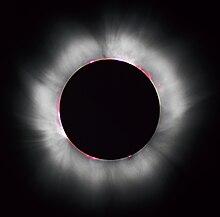User:Out of this World Adventure/Eclipse
Eclipse Info: <<< Last Solar Eclipse | Solar eclipse | Next Solar Eclipse >>> | <<< Last lunar eclipse | lunar eclipse | Next lunar eclipse >>>

A solar eclipse (as seen from the planet Earth) is a type of eclipse that occurs when the Moon passes between the Sun and Earth, and when the Moon fully or partially blocks ("occults") the Sun. This can happen only at new moon when the Sun and the Moon are in conjunction as seen from Earth in an alignment referred to as syzygy. In a total eclipse, the disk of the Sun is fully obscured by the Moon. In partial and annular eclipses, only part of the Sun is obscured.
If the Moon were in a perfectly circular orbit, a little closer to the Earth, and in the same orbital plane, there would be total solar eclipses every new moon. However, since the Moon's orbit is tilted at more than 5 degrees to the Earth's orbit around the Sun, its shadow usually misses Earth. The Moon's orbit must cross Earth's ecliptic plane in order for an eclipse (both solar as well as lunar) to occur. In addition, the Moon's actual orbit is elliptical, often taking it far enough away from Earth that its apparent size is not large enough to block the Sun entirely. The orbital planes cross each other at a line of nodes resulting in at least two, and up to five, solar eclipses occurring each year; no more than two of which can be total eclipses. However, total solar eclipses are rare at any particular location because totality exists only along a narrow path on the Earth's surface traced by the Moon's shadow or umbra.
An eclipse is a natural phenomenon. However, in some ancient and modern cultures, solar eclipses were attributed to supernatural causes or regarded as bad omens. A total solar eclipse can be frightening to people who are unaware of its astronomical explanation, as the Sun seems to disappear during the day and the sky darkens in a matter of minutes.

User:Out of this World Adventure/Eclipse/Solar eclipse of August 21, 2017
The solar eclipse of August 21, 2017, dubbed "The Great American Eclipse" by the media, was a total solar eclipse visible within a band across the entire contiguous United States, passing from the Pacific to the Atlantic coasts. As a partial solar eclipse, it was visible on land from Nunavut in northern Canada to as far south as northern South America. In northwestern Europe and Africa, it was partially visible in the late evening. In Asia, it was visible only at the eastern extremity, the Chukchi Peninsula.
User:Out of this World Adventure/Eclipse/Solar eclipse of February 15, 2018
User:Out of this World Adventure/Eclipse/Solar eclipse of July 13, 2018
User:Out of this World Adventure/Eclipse/Solar eclipse of August 11, 2018
User:Out of this World Adventure/Eclipse/Solar eclipse of October 14, 2023
User:Out of this World Adventure/Eclipse/Solar eclipse of April 8, 2024
List of solar eclipses in the 21st century

A lunar eclipse occurs when the Moon passes directly behind Earth and into its shadow. This can occur only when the Sun, Earth, and the Moon are aligned (in syzygy) exactly or very closely so, with the planet in between. Hence, a lunar eclipse can occur only on the night of a full moon. The type and length of an eclipse depend on the Moon's proximity to either node of its orbit.
During a total lunar eclipse, Earth completely blocks direct sunlight from reaching the Moon. The only light reflected from the lunar surface has been refracted by Earth's atmosphere. This light appears reddish for the same reason that a sunset or sunrise does: the Rayleigh scattering of bluer light. Due to this reddish color, a totally eclipsed Moon is sometimes called a blood moon.
Unlike a solar eclipse, which can be viewed only from a certain relatively small area of the world, a lunar eclipse may be viewed from anywhere on the night side of Earth. A total lunar eclipse lasts a few hours, whereas a total solar eclipse lasts only a few minutes as viewed from any given place, due to the smaller size of the Moon's shadow. Also unlike solar eclipses, lunar eclipses are safe to view without any eye protection or special precautions, as they are dimmer than the full Moon.

A total lunar eclipse occurred on January 31, 2018. The Moon was near its perigee on January 30 and so may be described as a "supermoon". The previous supermoon lunar eclipse was in September 2015.
As it was also a blue moon, the second full moon in the calendar month of January 2018, it was referred to as a "super blue blood moon"; the term blood refers to the typical color of the Moon during a total lunar eclipse. This coincidence last occurred on December 30, 1982 for the eastern hemisphere, and otherwise before that on March 31, 1866. The next occurrence will be on January 31, 2037, one metonic cycle (19 years) later.
Solar Eclipse GIFs
[edit]User:Out of this World Adventure/Eclipse/Solar Eclipse GIFs
